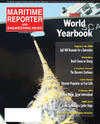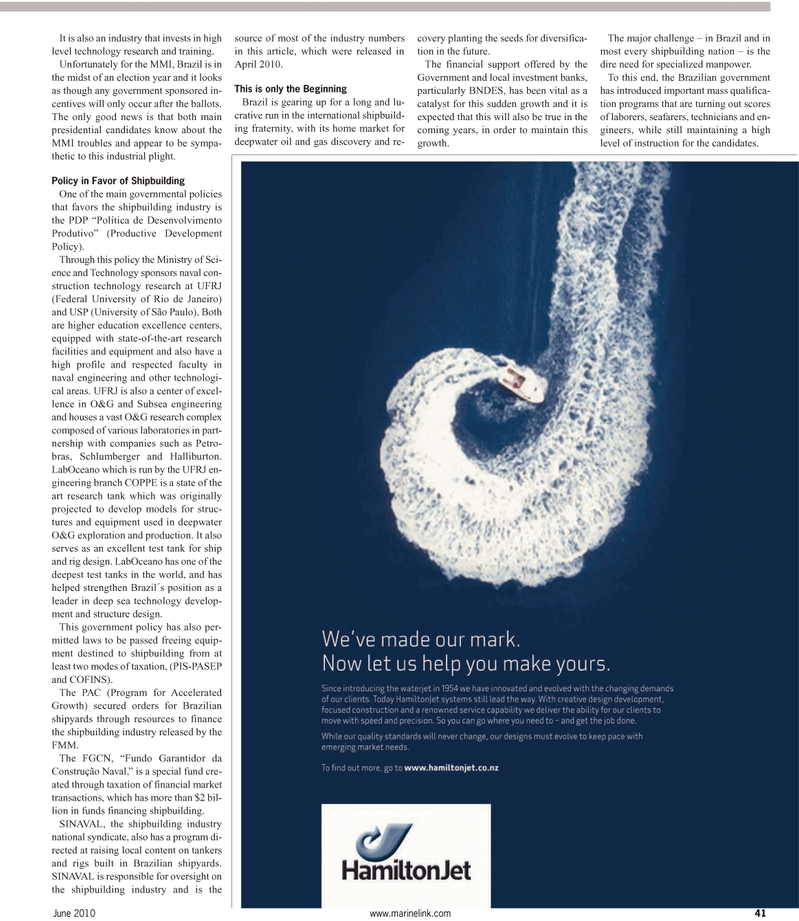
Page 41: of Maritime Reporter Magazine (June 2, 2010)
Read this page in Pdf, Flash or Html5 edition of June 2, 2010 Maritime Reporter Magazine
It is also an industry that invests in high level technology research and training.
Unfortunately for the MMI, Brazil is in the midst of an election year and it looks as though any government sponsored in- centives will only occur after the ballots.
The only good news is that both main presidential candidates know about the
MMI troubles and appear to be sympa- thetic to this industrial plight.
Policy in Favor of Shipbuilding
One of the main governmental policies that favors the shipbuilding industry is the PDP “Política de Desenvolvimento
Produtivo” (Productive Development
Policy).
Through this policy the Ministry of Sci- ence and Technology sponsors naval con- struction technology research at UFRJ (Federal University of Rio de Janeiro) and USP (University of São Paulo). Both are higher education excellence centers, equipped with state-of-the-art research facilities and equipment and also have a high profile and respected faculty in naval engineering and other technologi- cal areas. UFRJ is also a center of excel- lence in O&G and Subsea engineering and houses a vast O&G research complex composed of various laboratories in part- nership with companies such as Petro- bras, Schlumberger and Halliburton.
LabOceano which is run by the UFRJ en- gineering branch COPPE is a state of the art research tank which was originally projected to develop models for struc- tures and equipment used in deepwater
O&G exploration and production. It also serves as an excellent test tank for ship and rig design. LabOceano has one of the deepest test tanks in the world, and has helped strengthen Brazil´s position as a leader in deep sea technology develop- ment and structure design.
This government policy has also per- mitted laws to be passed freeing equip- ment destined to shipbuilding from at least two modes of taxation, (PIS-PASEP and COFINS).
The PAC (Program for Accelerated
Growth) secured orders for Brazilian shipyards through resources to finance the shipbuilding industry released by the
FMM.
The FGCN, “Fundo Garantidor da
Construção Naval,” is a special fund cre- ated through taxation of financial market transactions, which has more than $2 bil- lion in funds financing shipbuilding.
SINAVAL, the shipbuilding industry national syndicate, also has a program di- rected at raising local content on tankers and rigs built in Brazilian shipyards.
SINAVAL is responsible for oversight on the shipbuilding industry and is the source of most of the industry numbers in this article, which were released in
April 2010.
This is only the Beginning
Brazil is gearing up for a long and lu- crative run in the international shipbuild- ing fraternity, with its home market for deepwater oil and gas discovery and re- covery planting the seeds for diversifica- tion in the future.
The financial support offered by the
Government and local investment banks, particularly BNDES, has been vital as a catalyst for this sudden growth and it is expected that this will also be true in the coming years, in order to maintain this growth.
The major challenge – in Brazil and in most every shipbuilding nation – is the dire need for specialized manpower.
To this end, the Brazilian government has introduced important mass qualifica- tion programs that are turning out scores of laborers, seafarers, technicians and en- gineers, while still maintaining a high level of instruction for the candidates.
June 2010 www.marinelink.com 41

 40
40

 42
42
